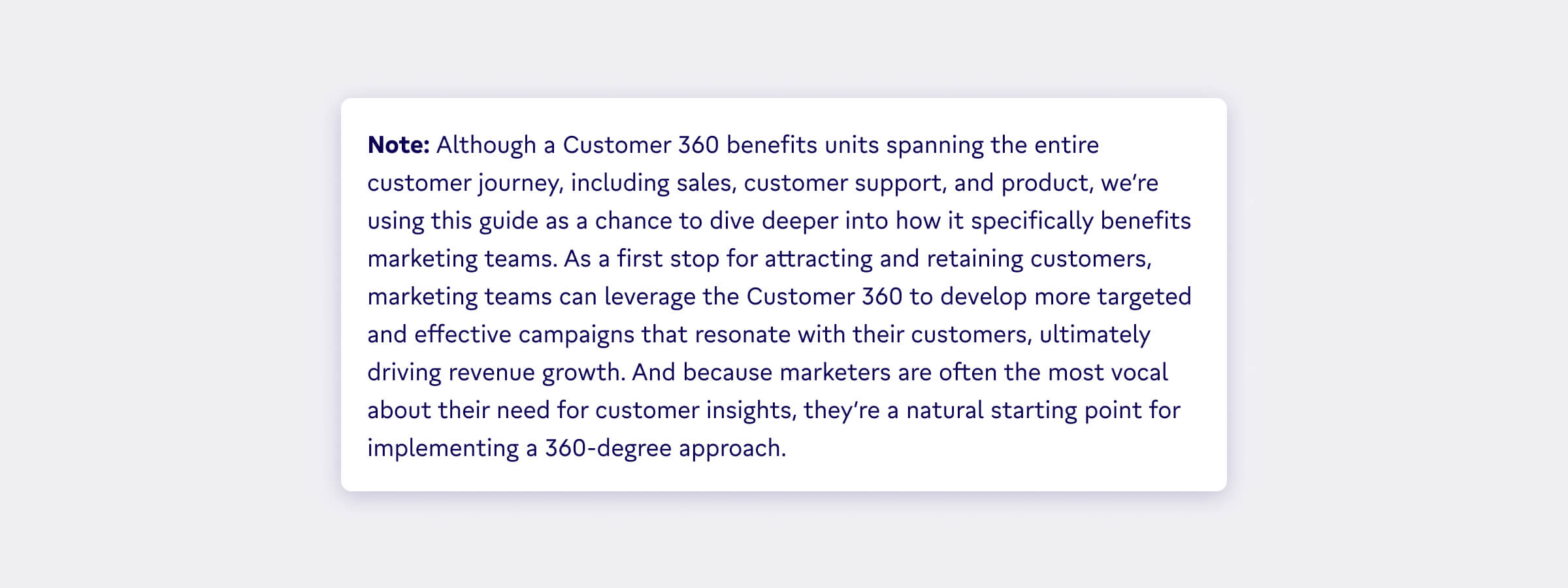Picture this: You're on a quest, armed with your trusty marketing sword and a shield of data, ready to conquer the elusive, mythical creature known as the "Customer 360." 🐉
Legends have been passed down through the marketing realm, filling our heads with tales of the ultimate, all-knowing view of our customers. But this "myth" we're chasing isn't a myth at all. It's very real — and it's quickly gaining popularity.
It’s no surprise, really; having a complete and comprehensive view of each customer, consolidated into a single profile, helps businesses better understand behavior, preferences, and needs. Insights garnered from Customer 360s are helping teams deliver personalized experiences that delight customers, give them what they need, and keep them coming back.
If you’re thinking about how to build a Customer 360, or have already done so, you’re ahead of the game. But watch out! ⚠️ You may be thinking about a Customer 360 wrong. Many myths abound about how they are built, who they are for, and what they can do for your organization.
So, we’re sharing five common myths about the Customer 360.
Think they aren’t a fit for your organization?
Worried this is a technical endeavor?
Don’t get hung up on any of these ideas. These are all the common Customer 360 misconceptions, so you know what's real and what's not when you start building one.👇
Myth 1: It's just about data collection
Some people assume creating a Customer 360 is all about collecting data from various sources. Of course, data is an essential component of a Customer 360 view, but it's not the only factor.
A Customer 360 gives you a comprehensive view of a customer across every touchpoint — it shows when and how the customer interacted with your business, the marketing messages they’ve received, and much more. This is powerful information that can demonstrate customer intent and allow you to proactively communicate.
The goal is to gain a deeper understanding of customers and their needs, not to blindly gather information in a dashboard where it will sit and gather dust. That's why you need Data Activation — warehouse-native Data Activation to be specific.
Warehouse-native Data Activation is the process of unlocking and transforming raw, disparate data, often stored within a data warehouse or data lake, into actionable insights that inform and enhance business decisions and customer experiences.
Simply put, it acts as the critical bridge that links raw data to meaningful, business-enhancing outcomes. By connecting to your existing first-party data, it transforms the data you already have into a format easily understood and used by both data and marketing teams.
Myth 2: It's too complex
The complexity associated with a Customer 360 is kind of like the way some people think about assembling a massive Lego set. They look at the huge box, the gazillion tiny pieces, and the thick instruction manual, and think, "This is way too complicated. I can't possibly do this."
Creating a Customer 360 is seen as this enormous, complicated project that requires too much time, too many resources, and too much technical know-how. But, just like with the Lego set, once you get started, once you have the right tools, and once you're following the right instructions, things start falling into place.
What once seemed like an insurmountable task becomes manageable, piece by piece. The same applies to creating a Customer 360 view — if you're prepared, if you've got the right data tools, and if you're activating your data in the right way, it's not that complex.
And just imagine having a crystal-clear view of your customer — knowing their preferences, their behaviors, their needs. It's like having a superpower that lets you anticipate what your customers want even before they know it themselves. It supercharges your marketing, boosts your sales, and makes your customers feel valued and understood.
So, while getting to that Customer 360 view might seem a bit challenging at first glance. But when you break it down, when you use the right tools, when you activate your data — it's not just achievable; it's totally worth it. The complexity? That's just a myth.
Myth 3: Customer 360 is only for large enterprises 🏢
The Customer 360 might sound complicated to set up. After all, you have to connect structured and unstructured data sources, make sure you have the right system in place, and have the team available to implement. Many mistakenly see the Customer 360 as expensive and labor intensive, believing it’s much better suited for large enterprises rather than for the little guys.
This is a myth. Many small and mid-sized companies are benefiting from Customer 360. Not only are they able to gain a single view of their customers, but they’re also able to implement and maintain a Customer 360 program with ease.
For example, Smartify is a nimble organization currently gaining benefits from Customer 360s. The team is currently using Census as a Reverse ETL solution that helps them populate Customer.io, their customer engagement platform, with the customer data they need.
Myth 4: It's a one-time project
It’s tempting to see the creation of Customer 360s as a one-time effort. Many teams think that they can simply connect the data sources to populate customer profiles and move on to focus on other projects. But if you take a “set it and forget it” approach, then you won’t be able to reap all the benefits of the strategy.
📣 News flash 📣
Customer 360s require continuous monitoring and updating.
When it comes to a Customer 360, challenges abound. These challenges are surmountable and shouldn’t deter you from the effort, but they do mean you can’t expect a one-time effort. Challenges such as data integration, data quality, change management, and scalability all require you to continually monitor your Customer 360 strategy to ensure you’re getting the most accurate view of your customers.
Not to mention, customer data is always changing (i.e. engagement, behavioral, demographic data changes often). To have an accurate view of your customers, you need to stay on top of these updates.
The Customer 360 is uniquely powerful. To have the most success, you’ll need to integrate it as part of your overall strategy. It’s an ongoing endeavor, not a one-time fix.
Myth 5: Customer 360 is only for marketing and sales 📢
Marketing and sales teams are often the ones who are obsessive about reaching prospects and customers. They want to understand exactly who their customers are so they can create campaigns, refine messaging, and ultimately make more sales. For this reason, many believe that Customer 360 is only for marketing and sales.
This is far from the truth. Customer 360 is powerful because it can benefit each and every department. Marketing might be the most vocal about Customer 360, but customer support, product engineering, and other teams can benefit as well.
Product and engineering teams can use Customer 360 to understand what parts of the product are used so they can then be savvy about further product development. Customer service and customer success teams can use Customer 360, as well.
When a customer gets in touch with a support request, they’re able to see everything that the customer has done so they can create a more personalized (and better!) support experience. For example, a customer might ask a question about how to import data into your product. In the Customer 350, the customer support agent can see that they’re a brand new customer and provide additional resources to help them on their way.

|
Getting to the bottom of it
In a world where our customers are just a tap away, and their expectations are higher than ever, understanding them deeply is not just beneficial, it's essential. A Customer 360 view lets us do just that – by diving into the world of our customers and providing insights that help us create more personalized, meaningful connections.
Sure, there are myths out there. Some people might say it's too complex, or it demands too much time and too many resources. But let's look at these myths for what they are — a result of misinterpretations or a lack of the right tools and strategy.
The key is to have robust data tools, a clear plan, and a focus on data activation. With these, the process of integrating and analyzing data from multiple customer touchpoints becomes much simpler.
As for the myth about the heavy investment of time and resources, reframe your thinking. It's an investment in your customers and, by extension, your business's future. The returns in the form of increased customer satisfaction, loyalty, and growth make it worthwhile.
Embrace the Customer 360 as a powerful tool that can transform your understanding of your customers, making your business more customer-centric, more responsive, and ultimately, more successful.
So, don't let the myths deter you. Instead, see them as stepping stones, guiding you to refine your approach, adjust your mindset, and realize the tremendous potential of a Customer 360 view. Remember, at the end of the day, it's all about your customers – understanding them, connecting with them, and delivering the value they seek.
👀 Ready to see how data activation can help you get the Customer 360 of your dreams? Get a sneak peek from one of our product specialists to see how we can help you build audience segments, and sync customer data to all your marketing and advertising tools, without any code. 💪


















